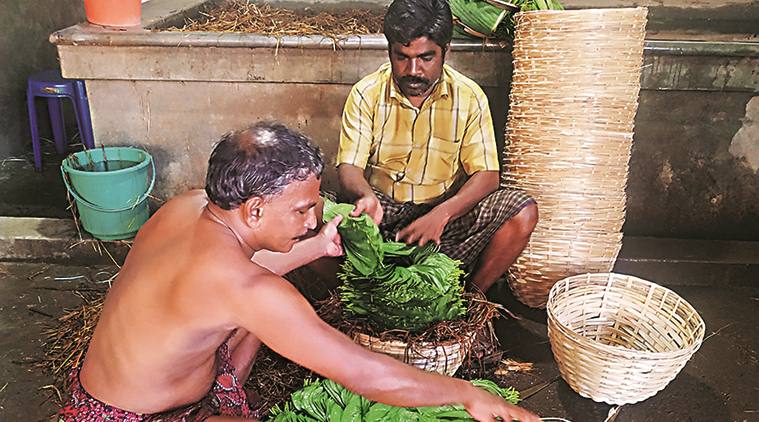 Workers packing betel leaves in Tirur, Malappuram. (Express photo by Vishnu Varma)
Workers packing betel leaves in Tirur, Malappuram. (Express photo by Vishnu Varma)
There was a time when the smell of freshly-plucked vettila (Malayalam for betel leaves) would waft through the centre of Tirur town in Malappuram district of north Kerala, recalls Alikutty, manager at T K Mohammed & Co, one of the oldest firms trading in betel leaves in the town.
Every evening, the town’s historic Paan Bazaar Street would be lined with trucks laden with betel leaves. Hundreds of workers would then begin the laborious process of unloading, washing and then re-packing the leaves with moistened straw in little cane baskets. By night, the baskets would be on their way to the local railway station, from where they would eventually make their way to markets in north India and onward to cities such Karachi and Lahore in Pakistan, where Tirur’s spicy, thick-stalked variety of leaves were much in demand.
But for Alikutty, all that feels like a different era now. Ever since Pakistan imposed a steep 140% import tax on the betel leaf in 2016, exports have ground to a halt and business has fallen drastically. With prices plummeting, a lot of farmers moved away from betel leaf cultivation.
“When I came into this field in 1983, there were over a hundred trading companies. Today, there are less than 15. Earlier, we used to send out 20 tonnes of leaves a day. Today, we barely send four tonnes, all of which go to Delhi, Uttar Pradesh, Rajasthan and other markets,” says Alikutty.
But amid this grim mood, what has generated hope among the farmers is the announcement of the Geographical Indication (GI) tag for the Tirur betel leaf variety. Last month, state Agriculture Minister V S Sunil Kumar formally handed over the GI recognition to a collective of farmers in the town, promising them that the tag would help them brand the leaf better and reach the best markets. He also said the government would explore other uses of the leaf, including exploring its application in Ayurveda.
Indira Devi, director of research at Kerala Agricultural University (KAU), Thrissur, who was among those who pursued the GI tag for the leaf, said, “There’s a specific chemical attribute called eugenol in betel leaves. When we analysed and compared it to other betel varieties across India, we found the eugenol content to be high in the Tirur variety. The high eugenol content is a major determining factor (for the GI tag) as it gives the leaf a special desirable quality for chewing and influences its smell and taste,” she said, adding, “The GI tag can certainly aid in the product’s visibility and credibility.”
According to a 2017-18 report of the KAU, betel vine, classified as a beverage crop along the likes of areca nut and cocoa, is cultivated on 268 hectares across Kerala, of which 130 hectares is in regions surrounding Tirur.
The betel vine, cultivation of which is highly labour-intensive, flourishes in well-drained soil and requires irrigation at regular intervals.
On his one-acre farm, five km from Tirur town, Mohammed Haji has been growing betel vines for the past three decades.
“In the days that I started cultivation, land sizes were big. As land shrunk, cultivation dropped. Besides, labour costs today are high. For a day’s work of planting and plucking, you need to pay a labourer Rs 900-1,000. Since the prices are low, the profit margins are slim,” says Haji, who is among the rare farmers who grow the vines both as an intercrop along with areca nut trees as well as in clusters, locally known as ‘koottakodi’.
Shahul Hameed, who grows betel vines on a small patch of land, says youngsters have been steadily opting out of betel leaf farming. “This is a crop that needs a lot of care. But the upside is that it gives you a good yield if all goes well. If you can manage the crop yourself, without additional labour, betel farming can give you profits that equal a government officer’s monthly salary,” he says.
Fifteen kilometres away, Unni, who followed in his father’s footsteps to take up betel leaf cultivation, says the future of the crop hinges a lot on government support. While he says the GI tag is a good move, he says the crop has still not got its “rightful due”.
“Every time we ask railway officials if they can extend the stoppage time of a train by an extra two minutes so that we can load the supplies, they simply shrug and ask, ‘It’s just betel leaves, right?’ That’s the attitude. They’ve never looked at it as a high-value commodity,” he says, adding, “It’s because they associate it with chewing. People need to know that betel leaves, by themselves, don’t cause harm. It’s when tobacco is introduced to the mixture that it causes cancer. People aren’t told about these things.”
With Indo-Pak ties still frosty, Unni says he has no hope that the trade will pick up any time soon.
“The situation is still uncertain. What the government needs to do is explore how value-added products can be created out of betel leaf. They must open research centers and find out if the by-products of the leaf can be marketed as toothpaste, beauty products or even in Ayurvedic medicine,” he says.